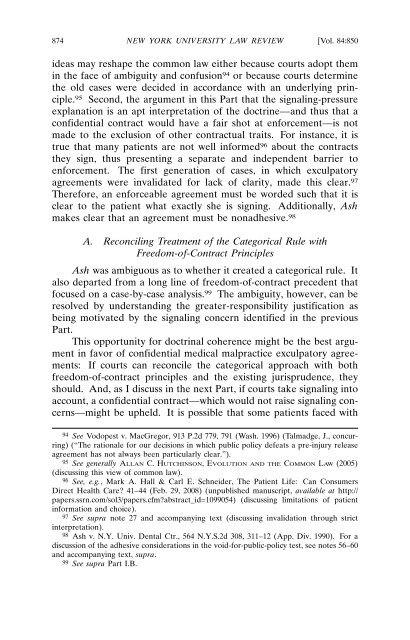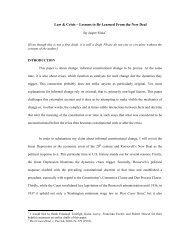In Search of an Enforceable Medical Malpractice Exculpatory
In Search of an Enforceable Medical Malpractice Exculpatory
In Search of an Enforceable Medical Malpractice Exculpatory
You also want an ePaper? Increase the reach of your titles
YUMPU automatically turns print PDFs into web optimized ePapers that Google loves.
874 NEW YORK UNIVERSITY LAW REVIEW [Vol. 84:850<br />
ideas may reshape the common law either because courts adopt them<br />
in the face <strong>of</strong> ambiguity <strong>an</strong>d confusion 94 or because courts determine<br />
the old cases were decided in accord<strong>an</strong>ce with <strong>an</strong> underlying principle.<br />
95 Second, the argument in this Part that the signaling-pressure<br />
expl<strong>an</strong>ation is <strong>an</strong> apt interpretation <strong>of</strong> the doctrine—<strong>an</strong>d thus that a<br />
confidential contract would have a fair shot at enforcement—is not<br />
made to the exclusion <strong>of</strong> other contractual traits. For inst<strong>an</strong>ce, it is<br />
true that m<strong>an</strong>y patients are not well informed 96 about the contracts<br />
they sign, thus presenting a separate <strong>an</strong>d independent barrier to<br />
enforcement. The first generation <strong>of</strong> cases, in which exculpatory<br />
agreements were invalidated for lack <strong>of</strong> clarity, made this clear. 97<br />
Therefore, <strong>an</strong> enforceable agreement must be worded such that it is<br />
clear to the patient what exactly she is signing. Additionally, Ash<br />
makes clear that <strong>an</strong> agreement must be nonadhesive. 98<br />
A. Reconciling Treatment <strong>of</strong> the Categorical Rule with<br />
Freedom-<strong>of</strong>-Contract Principles<br />
Ash was ambiguous as to whether it created a categorical rule. It<br />
also departed from a long line <strong>of</strong> freedom-<strong>of</strong>-contract precedent that<br />
focused on a case-by-case <strong>an</strong>alysis. 99 The ambiguity, however, c<strong>an</strong> be<br />
resolved by underst<strong>an</strong>ding the greater-responsibility justification as<br />
being motivated by the signaling concern identified in the previous<br />
Part.<br />
This opportunity for doctrinal coherence might be the best argument<br />
in favor <strong>of</strong> confidential medical malpractice exculpatory agreements:<br />
If courts c<strong>an</strong> reconcile the categorical approach with both<br />
freedom-<strong>of</strong>-contract principles <strong>an</strong>d the existing jurisprudence, they<br />
should. And, as I discuss in the next Part, if courts take signaling into<br />
account, a confidential contract—which would not raise signaling concerns—might<br />
be upheld. It is possible that some patients faced with<br />
94 See Vodopest v. MacGregor, 913 P.2d 779, 791 (Wash. 1996) (Talmadge, J., concurring)<br />
(“The rationale for our decisions in which public policy defeats a pre-injury release<br />
agreement has not always been particularly clear.”).<br />
95 See generally ALLAN C. HUTCHINSON, EVOLUTION AND THE COMMON LAW (2005)<br />
(discussing this view <strong>of</strong> common law).<br />
96 See, e.g., Mark A. Hall & Carl E. Schneider, The Patient Life: C<strong>an</strong> Consumers<br />
Direct Health Care? 41–44 (Feb. 29, 2008) (unpublished m<strong>an</strong>uscript, available at http://<br />
papers.ssrn.com/sol3/papers.cfm?abstract_id=1099054) (discussing limitations <strong>of</strong> patient<br />
information <strong>an</strong>d choice).<br />
97 See supra note 27 <strong>an</strong>d accomp<strong>an</strong>ying text (discussing invalidation through strict<br />
interpretation).<br />
98 Ash v. N.Y. Univ. Dental Ctr., 564 N.Y.S.2d 308, 311–12 (App. Div. 1990). For a<br />
discussion <strong>of</strong> the adhesive considerations in the void-for-public-policy test, see notes 56–60<br />
<strong>an</strong>d accomp<strong>an</strong>ying text, supra.<br />
99 See supra Part I.B.
















